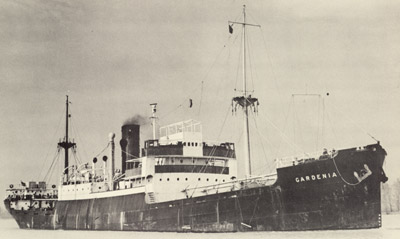Table of Contents
The wanderings of the salt water visitors to our Great Lakes are often difficult to trace. Some make but one visit to the lakes in their lifetime, while others may ply the inland seas for a number of years. Recently some information about the former Stag Line steamer GARDENIA came to light that might be worth sharing since that vessel was a regular trader to the lakes from 1959 to 1963.

Fred Sankoff caught GARDENIA upbound near Homer on April 24, 1960.
GARDENIA was one of the oldest ships to enter the lakes after the opening of the St. Lawrence Seaway in 1959. She was classed as a traditional three-island tramp ship of single deck construction and had her engines located amidship. GARDENIA had two holds and hatches forward of the bridge, one hold and hatch between the bridge and engineroom, and two holds and hatches aft of the engineroom.
The vessel was launched in 1930 by the Northumberland Shipbuilding Co. Ltd. at Newcastle-on-Tyne, England, as Hull No. 427. She measured 377 feet in overall length (364.8 registered), 50.9 feet at the beam and 24.9 feet in depth. Gross tonnage was registered at 4,125 tons while her net was 2,643 tons. Her carrying capacity was 6,485 tons at a mid-summer draft of 22'6 1/2". She was christened BRIARWOOD (III) and entered service for the Constantine Shipping Co. Ltd. of Middlesborough, England. In 1932 her ownership was transferred to the Joseph Constantine Steamship Line Ltd. This company was no stranger to the Canadian service. Its vessels called regularly at Montreal and several small ships traded into the lakes prior to the opening of the Seaway.
The pressures of World War II taxed the entire United Kingdom whose shipping industry was faced with the task of supplying the homeland and supporting allied nations. In 1941, Hitler turned his forces to the Russian front and, to assist the defence of Russia, Britain and her allies sent convoys of merchant vessels guarded by naval escorts to the northern Russian ports of Archangel on the White Sea and Murmansk on the Barents Sea. These supply-carrying convoys began in August of 1941 and this ship, still called BRIARWOOD, had the dubious honour of taking part in the first convoy as well as many subsequent northern voyages. Miraculously escaping the violent destruction that was the fate of so many of the vessels participating in the disastrous Arctic convoys, she remained on this hazardous route until the spring of 1943 when she was transferred to other service.
After the war, BRIARWOOD was purchased by the Stag Line Ltd. of North Shields, England. They had originally planned to rename her ZINNIA, but on December 13, 1945, she was officially renamed GARDENIA. All Stag Line vessels are named for various types of flora. (interestingly enough, another ship named ZINNIA was to become a running mate for GARDENIA on the lakes service). The steamer was given the traditional Stag Line colours, dark red stack with a black top superimposed on which was a large white stag in very intricate detail.
The propulsion for the vessel was supplied by a North Eastern Marine triple expansion engine with cylinders of 23, 38 and 65 inches and a 42-inch stroke. It produced an indicated horsepower of about 1500 and a speed of 9 1/2 knots while laden with 17 tons of fuel oil. Originally her two main Scotch boilers were coal-fired. Each boiler measured 15'3" by 11'6" and was fired by four furnaces. One Scotch donkey boiler was also installed. During 1947-48, she was reconditioned and converted to oil fuel. Her donkey boiler was removed at that time.
When she returned to service, GARDENIA traded on the North Atlantic. Her most frequent cargo was timber which she carried back to the United Kingdom, GARDENIA occasionally ventured to the Caribbean and to the Mediterranean during these years. From 1952 to 1954, GARDENIA carried coal from Sydney, Nova Scotia, and newsprint from the St. Lawrence down to the U.S. Gulf area. In 1955 she served mainly in the bulk sugar trade from the Caribbean to Britain and the United States, Between 1956 and 1959 she spent most of her time carrying grain from Eastern Canada to the U.K. During warmer months she entered Hudson Bay to load at Churchill, Manitoba. In almost all of these voyages, she would make the outbound trip to North America in ballast.
In preparation for the beginning of Seaway navigation, GARDENIA and CAMELLIA, another Stag Line vessel, were chartered for grain from the lakes and were the first British owned ships to be chartered for direct grain shipments from the Great Lakes to the United Kingdom. The charter agreement was signed on November 12, 1958.
During her five seasons of Great Lakes trading, GARDENIA made seventeen trips through the Seaway. She ballasted into the lakes on three occasions, brought in steel beams once, potash once, and fluorspar on the balance of her voyages. Outbound, she carried scrap on one occasion, the remaining cargoes consisting of grain including wheat, barley, corn and flaxseed.
In 1964, Stag Line sold GARDENIA to Amfitriti Cia. Nav., Panama, who renamed her AIS NICOLAS. She was sold early in 1967 to Astrosplendor Cia. Nav., also of Panama, and continued to operate until the fall of 1968 when she encountered boiler trouble while under way on the Persian Gulf, on a voyage from Assab. She arrived in tow at Suez on August 31, 1968. On October 20th, while repairs wore apparently under way, fire broke out in the engineroom and she suffered very extensive damage. Her remains were sold and apparently broken up in 1969 for scrap.
Much of the above information was kindly supplied by Nicholas J. Robinson, a director of the Stag Line, to whom we are indebted for his assistance.
Previous Next
Return to Home Port or Toronto Marine Historical Society's Scanner
Reproduced for the Web with the permission of the Toronto Marine Historical Society.